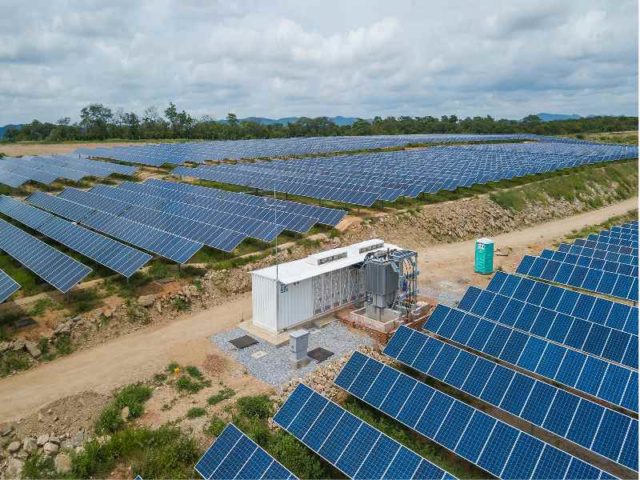As the cost of renewable energy solutions continues to drop and the demand for improved social and environmental compliance climbs, even the remotest mines in Africa are now starting to consider solar, wind and energy storage power supply options an investment-friendly and financially viable choice, Zest WEG Group’s Integrated Solutions executive ALASTAIR GERRARD tells LAURA CORNISH.
The uptake of renewable energy sources in the mining sector has been a slow moving transition – which can largely be attributed to the cost involved to establish a solar/wind power plant, the added costs associated with storing that energy, regulatory challenges and a limited track record in the industry.
“This is rapidly changing. The last year or two has seen a significant uptake in interest and securement of renewable energy power projects in the mining industry – which on a positive note is occurring across the African continent and not only in first world territories,” says Gerrard.
“The technology has matured rapidly and has consequently seen pricing decrease significantly. This has made the economics for renewable/alternative energy sources attractive,” he continues.
“Further to this, pressure from government and investors to improve environmental footprints by reducing carbon emissions is now one of the top five agenda items and incorporating renewable energy is an easy way to achieve this.”
Reliable and cost-effective energy, sourced and generated through private or internal arrangements that eliminates the possibility of unexpected power outages, answers another major challenge for the industry.
It eliminates unreliable grid power from government-owned entities such as Eskom in South Africa or poorly maintained/unavailable power infrastructure in other parts of Africa.
“South Africa’s mining and energy minister Gwede Mantashe is looking to alleviate this challenge by enabling mining companies to self-generate power without the need for regulatory approval. This is a positive step and could deliver massive results for an industry afflicted by regular load shedding considering 48% of energy intensive users in the country are mines,” Gerrard notes.
Status update
Gerrard does not foresee mining companies moving entirely away from traditional power solutions – grid connections and diesel-power generation – but does predict that reliance on these sources will continue to decrease.
“Within the next five years, I believe 20% to 50% of some of the African mining operations total power supply will be secured from renewable energy sources, supplemented by those traditional sources as back-up when needed,” he confirms.
For now, to reduce any risk associated with renewable energy sources, the energy executive specialist also anticipates that mining companies will continue to opt for hybrid solutions – a combination of energy sources that deliver a solution comprising an appropriate mix of energy technologies.
“This offers greater flexibility at a reduced cost overall, positively contributing to a return on investment.”
Gerrard sites Bloomberg, which recently revealed that various mining companies in South Africa are planning to build solar power plants, including a 200 MW plant already under development with Sibanye-Stillwater, a 75 MW facility planned by Anglo American, a 40 MW solar park by Gold Fields and a 200 MW PV plant by Vedanta.
Such initiatives don’t extend only to the county’s big mining houses. Junior mining company Orion Minerals, which is looking to reopen the Prieska zinc-copper mine in the Northern Cape, is in the process of establishing its own renewable power plant which for now could be have around 38 MW of installed capacity.
Further afield across the continent, B2Gold is looking to establish a 30 MW solar (with a battery storage component) and heavy fuel oil (HFO) plant for its Fekola mine in Mali while Resolute Mining has commenced construction of its 40 MW solar plant with battery storage at its Syama gold mine, also in Mali.
Leveraging its integrated solution approach
Zest WEG Group is well positioned to participate in this evolving energy market. With a combination of South African manufactured products and facilities, strategically located global factories, a strong distribution centre in South Africa and a network of distributors and agents throughout Africa, the company’s team of qualified individuals are dedicated to the development of this business area for the continent’s mining industry.
“Our Integrated Solutions division has extensive experience in delivering energy solutions on the African continent, which places the company as a serious contributor to support the mining industry in the development of efficient energy solutions,” Gerrard highlights.
To date, Zest WEG Group has always promoted an integrated energy solutions approach and has already delivered energy supply solutions in all forms to the mining industry including power generation plants, electrical infrastructure and mobile solutions (generators and substations).
In Brazil, parent company WEG has been successful in securing many projects in the renewable energy sector (both solar PV and wind projects) which has today developed into a mature business.
“We are now in the process of engaging with our team there to understand and develop our approach into this market throughout the African continent. Further to this, being a WEG subsidiary, we also have direct access to experienced resources and can leverage off well established global capabilities,” Gerrard concludes.



